Assessment and Factor Diagnosis of Water Resource Vulnerability in Arid Inland River Basin: A Case Study of Shule River Basin, China
Abstract
1. Introduction
2. Materials and Methods
2.1. Data Sources
2.2. Methods
2.2.1. Calculation Method of Index Weight
2.2.2. Matter-Element Model
2.2.3. Delphi Method Evaluation
2.2.4. Cloud Model
2.2.5. Obstacle Degree Model
3. Case Study
3.1. Overview of the Study Area
3.2. Evaluation System of Water Resource Vulnerability in Inland River Basins of Arid Zones
4. Results and Discussion
4.1. Results
4.1.1. Evaluation of the Value of the Grading Standard
4.1.2. Results of Weight Calculation
4.1.3. Assessment of Water Resource Vulnerability
4.1.4. Diagnostic Analysis of Factors Impact Water Resource Vulnerability
4.2. Discussion
- (1)
- As the impact of human activities and climate change on water resources intensifies in inland river basins in the arid area of northwest China, a single evaluation index is insufficient to reflect the complexity and vulnerability of water resources in river basins. If the evaluation indexes are too complex to be selected while establishing a multi-index evaluation system, it will lead to redundant and repetitive information. Few indexes will have a single response, and others will have incomplete information and indicators that are too specific. If selected indicators are specific, it is difficult to obtain and track the monitoring data to a certain extent, to have universality and representativeness, and to promote the practical application of the research results. In this study, via correlation analysis among indicators and expert consultation, the 16 impacting factors selected based on natural vulnerability, anthropogenic vulnerability, and carrying capacity vulnerability are representative, and the monitoring data are easily accessible and traceable, and, thereby, they have adaptability and practicality in the arid inland region of northwest China.
- (2)
- In terms of valuation ideas and methods of water resource vulnerability, most similar studies used objective or subjective single attribute evaluation methods, the results of which are rather one-sided and also difficult to cover the subjective and objective causes of water resource vulnerability. In the combined subjective and objective evaluation studies, the simple mean score method is often used as the combined method, which, to a certain extent, ignores the actual contribution of subjective and objective causes of water resource vulnerability. The actual contribution of the subjective and objective causes of water resource vulnerability in dryland basins has been ignored to some extent. This study used game theory for reconciliation and assignment, and the evaluation results use a fuzzy cloud model, avoiding the drawback of the unique certainty of evaluation results in similar quantitative studies and reflecting the uncertainty and ambiguity fuzziness of water resource vulnerability; thus, they can reflect the actual situation of water resource vulnerability more accurately.
- (3)
- Taking the evaluation results of the SLRB as an example, the results of this study are consistent with similar results and also correspond to the realities in the SLRB. The results of the barrier degree diagnosis showed that the most significant factor affecting the vulnerability of water resources is the vulnerability of carrying capacity in the SLRB, and the key influencing factors included the following: the irrigation water ratio of agricultural land, annual precipitation, total water resources, the annual discharge of wastewater, urbanization rate, surface water control rate, and the degree of groundwater development and utilization. This also shows that the water resources of arid inland river basin in China, especially of the SLRB, cannot maintain the sustainable development of oasis agriculture and ecological environment. At the same time, the intensification of human activities, displayed by the irrigation water use ratio, the annual discharge of wastewater, the urbanization rate, the surface water control rate, and the degree of groundwater exploitation and utilization, are the main factors affecting the vulnerability of water resources. Therefore, in order to reduce the vulnerability of water resources in arid inland river basins in northwestern China, it is better to adjust agricultural structure and effectively manage water resources in conjunction with the construction of surface water projects, further rationalizing the quantity and structure of water use in the river basins.
5. Conclusions
Author Contributions
Funding
Institutional Review Board Statement
Informed Consent Statement
Data Availability Statement
Acknowledgments
Conflicts of Interest
References
- Yang, Q.; Zhang, F.; Jiang, Z.; Yuan, D.; Jiang, Y. Assessment of Water Resource Carrying Capacity in Karst Area of Southwest China. Environ. Earth Sci. 2016, 75, 37. [Google Scholar] [CrossRef]
- Cacal, J.C.; Taboada, E.B. Assessment and Evaluation of IWRM Implementation in Palawan, Philippines. Civ. Eng. J. 2022, 8, 290–307. [Google Scholar] [CrossRef]
- Chen, Y.; Feng, Y.; Zhang, F.; Yang, F.; Wang, L. Assessing and Predicting the Water Resources Vulnerability under Various Climate-Change Scenarios: A Case Study of Huang-Huai-Hai River Basin, China. Entropy 2020, 22, 333. [Google Scholar] [CrossRef] [PubMed]
- Everard, M.; Sharma, O.P.; Vishwakarma, V.K.; Khandal, D.; Sahu, Y.K.; Bhatnagar, R.; Singh, J.K.; Kumar, R.; Nawab, A.; Kumar, A.; et al. Assessing the Feasibility of Integrating Ecosystem-Based with Engineered Water Resource Governance and Management for Water Security in Semi-Arid Landscapes: A Case Study in the Banas Catchment, Rajasthan, India. Sci. Total Environ. 2018, 612, 1249–1265. [Google Scholar] [CrossRef] [PubMed]
- Doerfliger, N.; Jeannin, P.Y.; Zwahlen, F. Water Vulnerability Assessment in Karst Environments: A New Method of Defining Protection Areas Using a Multi-Attribute Approach and GIS Tools (EPIK Method). Environ. Geol. 1999, 39, 165–176. [Google Scholar] [CrossRef]
- Vörösmarty, C.J.; Green, P.; Salisbury, J.; Lammers, R.B. Global Water Resources: Vulnerability from Climate Change and Population Growth. Science 2000, 289, 284–288. [Google Scholar] [CrossRef]
- Anandhi, A.; Kannan, N. Vulnerability Assessment of Water Resources–Translating a Theoretical Concept to an Operational Framework Using Systems Thinking Approach in a Changing Climate: Case Study in Ogallala Aquifer. J. Hydrol. 2018, 557, 460–474. [Google Scholar] [CrossRef]
- Xia, J.; Ning, L.; Wang, Q.; Chen, J.; Wan, L.; Hong, S. Vulnerability of and Risk to Water Resources in Arid and Semi-Arid Regions of West China under a Scenario of Climate Change. Clim. Chang. 2017, 144, 549–563. [Google Scholar] [CrossRef]
- Perveen, S.; James, L.A. Scale Invariance of Water Stress and Scarcity Indicators: Facilitating Cross-Scale Comparisons of Water Resources Vulnerability. Appl. Geogr. 2011, 31, 321–328. [Google Scholar] [CrossRef]
- Hamouda, M.A.; Nour El-Din, M.M.; Moursy, F.I. Vulnerability Assessment of Water Resources Systems in the Eastern Nile Basin. Water Resour. Manag. 2009, 23, 2697–2725. [Google Scholar] [CrossRef]
- Xu, W.; Zhang, X.; Cui, Y.; Tian, T.; Lin, L.; Liu, Y. Study on Comprehensive Evaluation of Urban Water Resource Vulnerability. Sustainability 2022, 14, 4149. [Google Scholar] [CrossRef]
- Alessa, L.; Kliskey, A.; Lammers, R.; Arp, C.; White, D.; Hinzman, L.; Busey, R. The Arctic Water Resource Vulnerability Index: An Integrated Assessment Tool for Community Resilience and Vulnerability with Respect to Freshwater. Environ. Manag. 2008, 42, 523–541. [Google Scholar] [CrossRef] [PubMed]
- Xia, J.; Chen, J.; Weng, J.; Yu, L.; Qi, J.; Liao, Q. Vulnerability of Water Resources and Its Spatial Heterogeneity in Haihe River Basin, China. Chin. Geogr. Sci. 2014, 24, 525–539. [Google Scholar] [CrossRef]
- Pan, Z.; Jin, J.; Li, C.; Ning, S.; Zhou, R. A Connection Entropy Approach to Water Resources Vulnerability Analysis in a Changing Environment. Entropy 2017, 19, 591. [Google Scholar] [CrossRef]
- Shabbir, R.; Ahmad, S.S. Water Resource Vulnerability Assessment in Rawalpindi and Islamabad, Pakistan Using Analytic Hierarchy Process (AHP). J. King Saud Univ.-Sci. 2016, 28, 293–299. [Google Scholar] [CrossRef]
- Cai, J.; Varis, O.; Yin, H. China’s Water Resources Vulnerability: A Spatio-Temporal Analysis during 2003–2013. J. Clean. Prod. 2017, 142, 2901–2910. [Google Scholar] [CrossRef]
- Kanakoudis, V.; Tsitsifli, S.; Papadopoulou, A.; Curk, B.C.; Karleusa, B. Estimating the Water Resources Vulnerability Index in the Adriatic Sea Region. Procedia Eng. 2016, 162, 476–485. [Google Scholar] [CrossRef]
- Wu, G.; Li, L.; Ahmad, S.; Chen, X.; Pan, X. A Dynamic Model for Vulnerability Assessment of Regional Water Resources in Arid Areas: A Case Study of Bayingolin, China. Water Resour. Manag. 2013, 27, 3085–3101. [Google Scholar] [CrossRef]
- Islam, A.R.M.T.; Pal, S.C.; Chakrabortty, R.; Idris, A.M.; Salam, R.; Islam, M.S.; Zahid, A.; Shahid, S.; Ismail, Z.B. A Coupled Novel Framework for Assessing Vulnerability of Water Resources Using Hydrochemical Analysis and Data-Driven Models. J. Clean. Prod. 2022, 336, 130407. [Google Scholar] [CrossRef]
- Abdullah, T.O.; Ali, S.S.; Al-Ansari, N.A.; Knutsson, S. Assessment of Groundwater Vulnerability to Pollution Using Two Different Vulnerability Models in Halabja-Saidsadiq Basin, Iraq. Groundw. Sustain. Dev. 2020, 10, 100276. [Google Scholar] [CrossRef]
- Liu, H.-L.; Willems, P.; Bao, A.-M.; Wang, L.; Chen, X. Effect of Climate Change on the Vulnerability of a Socio-Ecological System in an Arid Area. Glob. Planet. Chang. 2016, 137, 1–9. [Google Scholar] [CrossRef]
- Feng, Z.-D.; An, C.B.; Wang, H.B. Holocene Climatic and Environmental Changes in the Arid and Semi-Arid Areas of China: A Review. Holocene 2006, 16, 119–130. [Google Scholar] [CrossRef]
- Wang, G.; Cheng, G. The Characteristics of Water Resources and the Changes of the Hydrological Process and Environment in the Arid Zone of Northwest China. Environ. Geol. 2000, 39, 783–790. [Google Scholar] [CrossRef]
- Kang, E.; Cheng, G.; Lan, Y.; Jin, H. A Model for Simulating the Response of Runoff from the Mountainous Watersheds of Inland River Basins in the Arid Area of Northwest China to Climatic Changes. Sci. China Ser. D Earth Sci. 1999, 42, 52–63. [Google Scholar] [CrossRef]
- Zhang, Q.; Xu, H.; Li, Y.; Fan, Z.; Zhang, P.; Yu, P.; Ling, H. Oasis Evolution and Water Resource Utilization of a Typical Area in the Inland River Basin of an Arid Area: A Case Study of the Manas River Valley. Environ. Earth Sci. 2012, 66, 683–692. [Google Scholar] [CrossRef]
- Qi, S.-Z.; Luo, F. Water Environmental Degradation of the Heihe River Basin in Arid Northwestern China. Environ. Monit. Assess 2005, 108, 205–215. [Google Scholar] [CrossRef] [PubMed]
- Fisher, F.M.; Arlosoroff, S.; Eckstein, Z.; Haddadin, M.; Hamati, S.G.; Huber-Lee, A.; Jarrar, A.; Jayyousi, A.; Shamir, U.; Wesseling, H. Optimal Water Management and Conflict Resolution: The Middle East Water Project. Water Resour. Res. 2002, 38, 25-1–25-17. [Google Scholar] [CrossRef]
- Meng, L.; Chen, Y.; Li, W.; Zhao, R. Fuzzy Comprehensive Evaluation Model for Water Resources Carrying Capacity in Tarim River Basin, Xinjiang, China. Chin. Geogr. Sci. 2009, 19, 89–95. [Google Scholar] [CrossRef]
- Habibi Davijani, M.; Banihabib, M.E.; Nadjafzadeh Anvar, A.; Hashemi, S.R. Multi-Objective Optimization Model for the Allocation of Water Resources in Arid Regions Based on the Maximization of Socioeconomic Efficiency. Water Resour. Manag. 2016, 30, 927–946. [Google Scholar] [CrossRef]
- Parween, F.; Kumari, P.; Singh, A. Irrigation Water Pricing Policies and Water Resources Management. Water Policy 2020, 23, 130–141. [Google Scholar] [CrossRef]
- Song, M.; Wang, R.; Zeng, X. Water Resources Utilization Efficiency and Influence Factors under Environmental Restrictions. J. Clean. Prod. 2018, 184, 611–621. [Google Scholar] [CrossRef]
- Wu, L. River Network Dataset of the Shulehe River Basin. 2021. Available online: http://www.ncdc.ac.cn/portal/metadata/4812007d-7c7c-4f64-a787-3f60d667f8ef (accessed on 30 May 2023).
- Thungngern, J.; Wijitkosum, S.; Sriburi, T.; Sukhsri, C. A Review of the Analytical Hierarchy Process (AHP): An Approach to Water Resource Management in Thailand. Appl. Environ. Res. 2015, 37, 13–32. [Google Scholar] [CrossRef]
- Jenifer, M.A.; Jha, M.K. Comparison of Analytic Hierarchy Process, Catastrophe and Entropy Techniques for Evaluating Groundwater Prospect of Hard-Rock Aquifer Systems. J. Hydrol. 2017, 548, 605–624. [Google Scholar] [CrossRef]
- Zhu, D.; Wang, R.; Duan, J.; Cheng, W. Comprehensive Weight Method Based on Game Theory for Identify Critical Transmission Lines in Power System. Int. J. Electr. Power Energy Syst. 2021, 124, 106362. [Google Scholar] [CrossRef]
- Jolson, M.A.; Rossow, G.L. The Delphi Process in Marketing Decision Making. J. Mark. Res. 1971, 8, 443–448. [Google Scholar] [CrossRef]
- Cui, C.; Wang, B.; Zhao, Y.; Zhang, Y.-J.; Xue, L. Risk Management for Mine Closure: A Cloud Model and Hybrid Semi-Quantitative Decision Method. Int. J. Miner. Metall. Mater. 2020, 27, 1021–1035. [Google Scholar] [CrossRef]
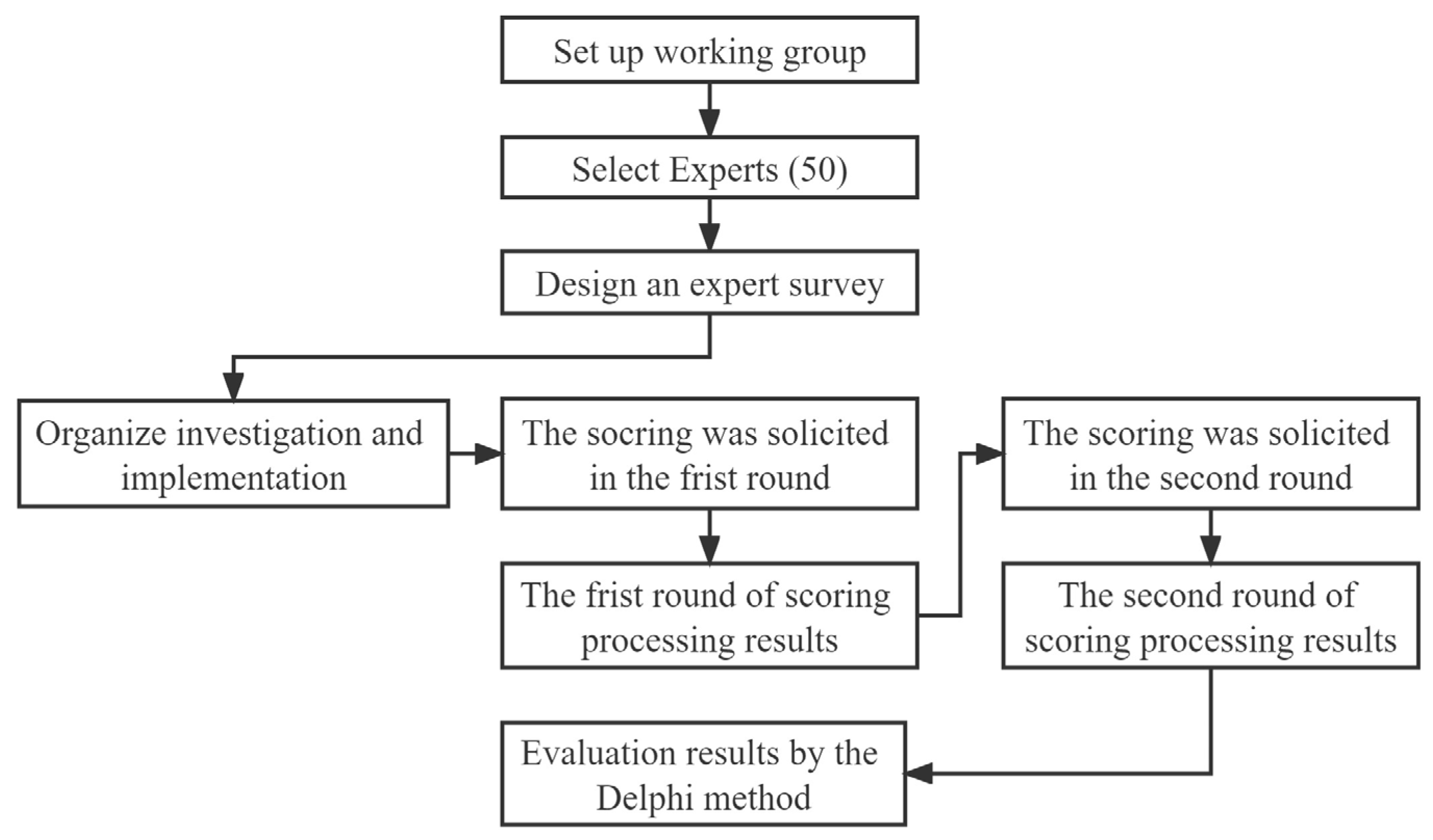

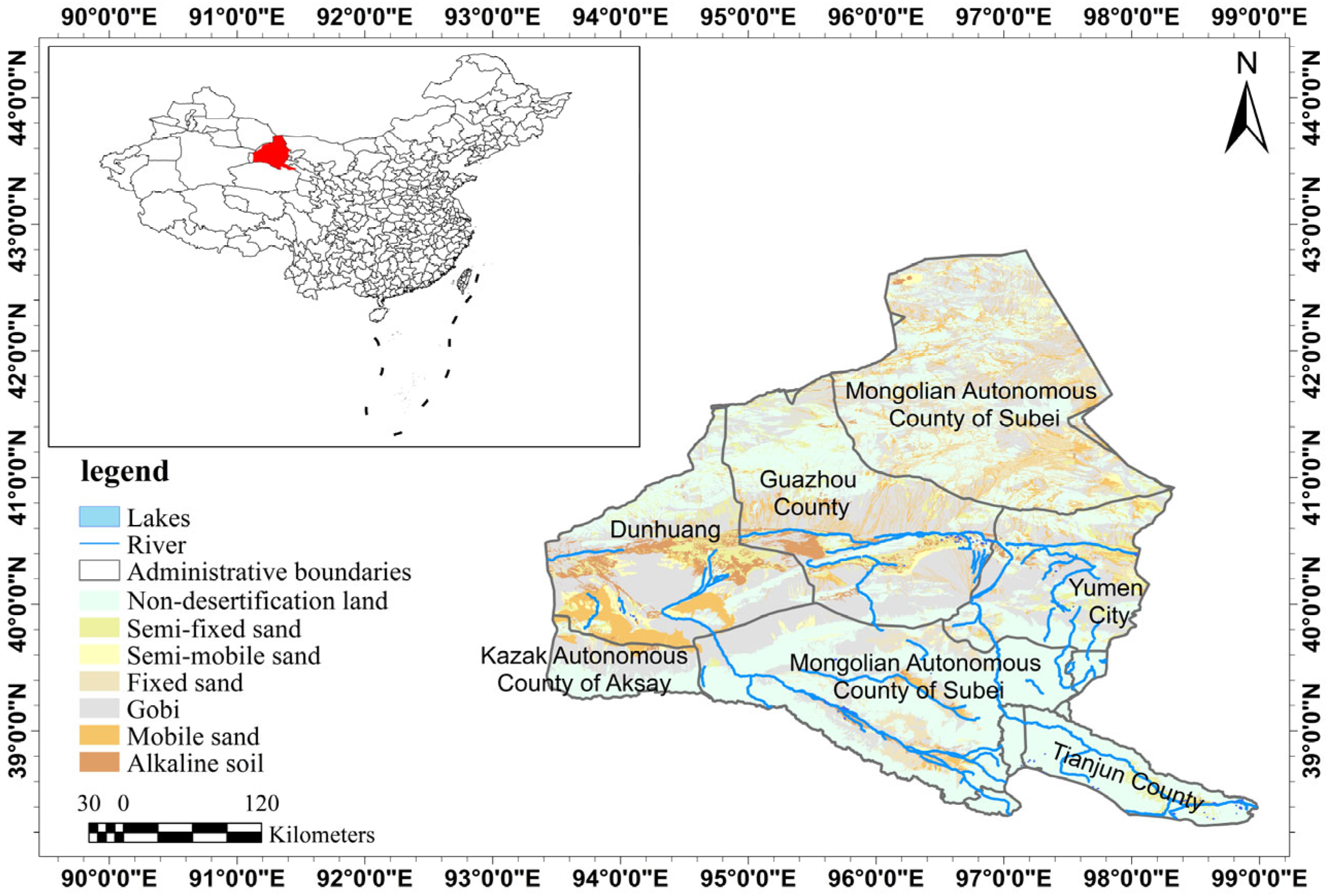
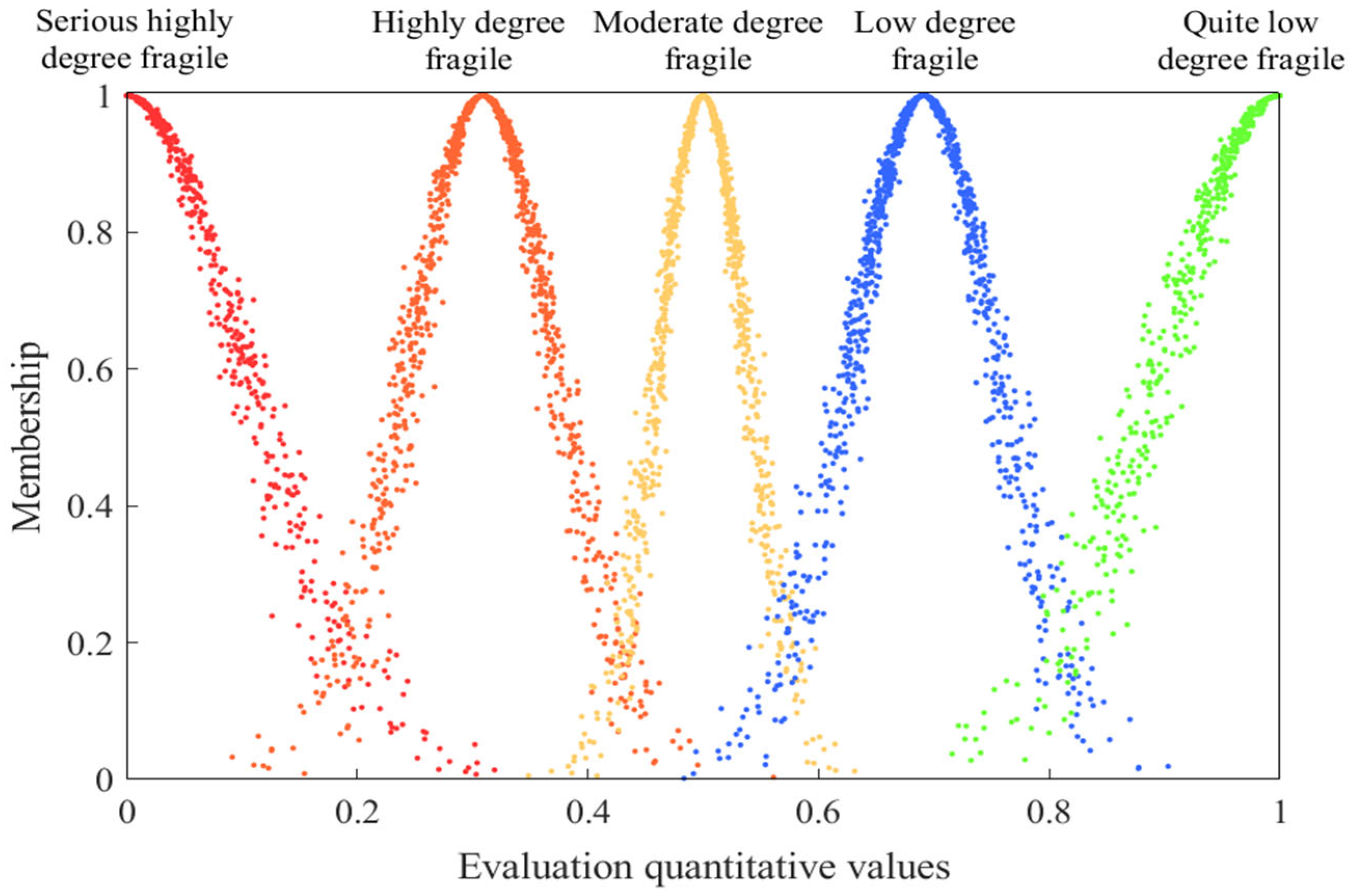
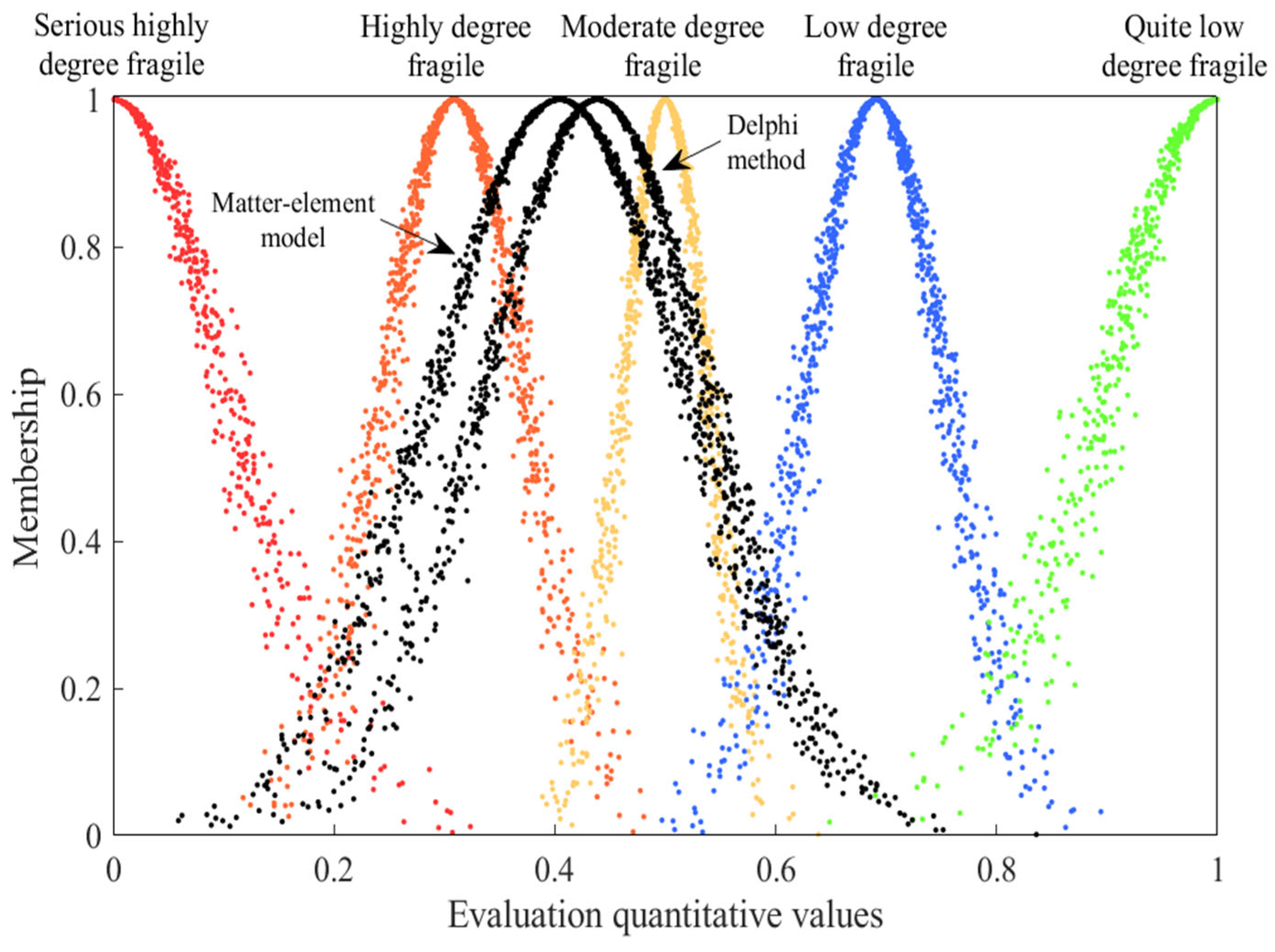
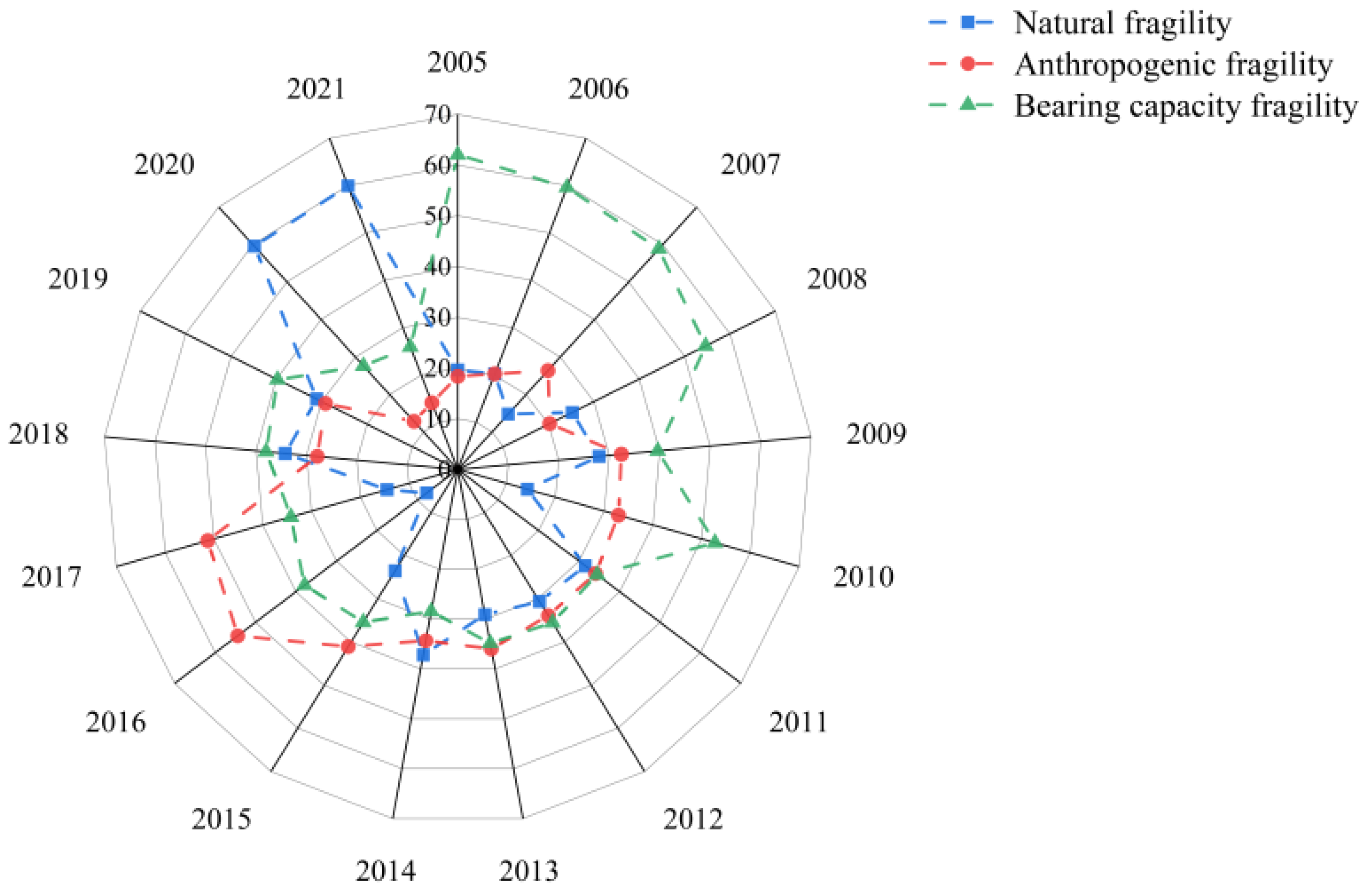
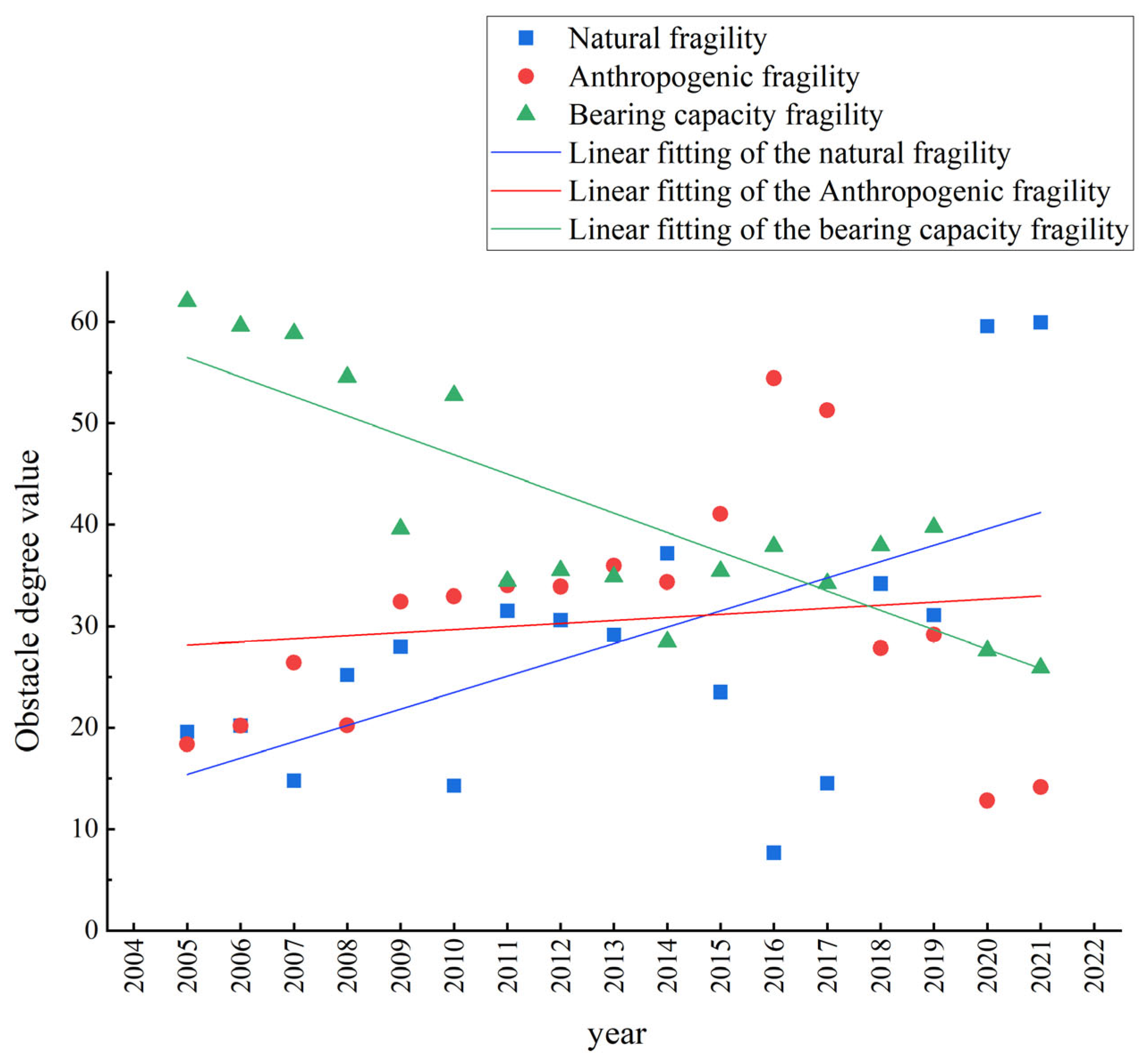
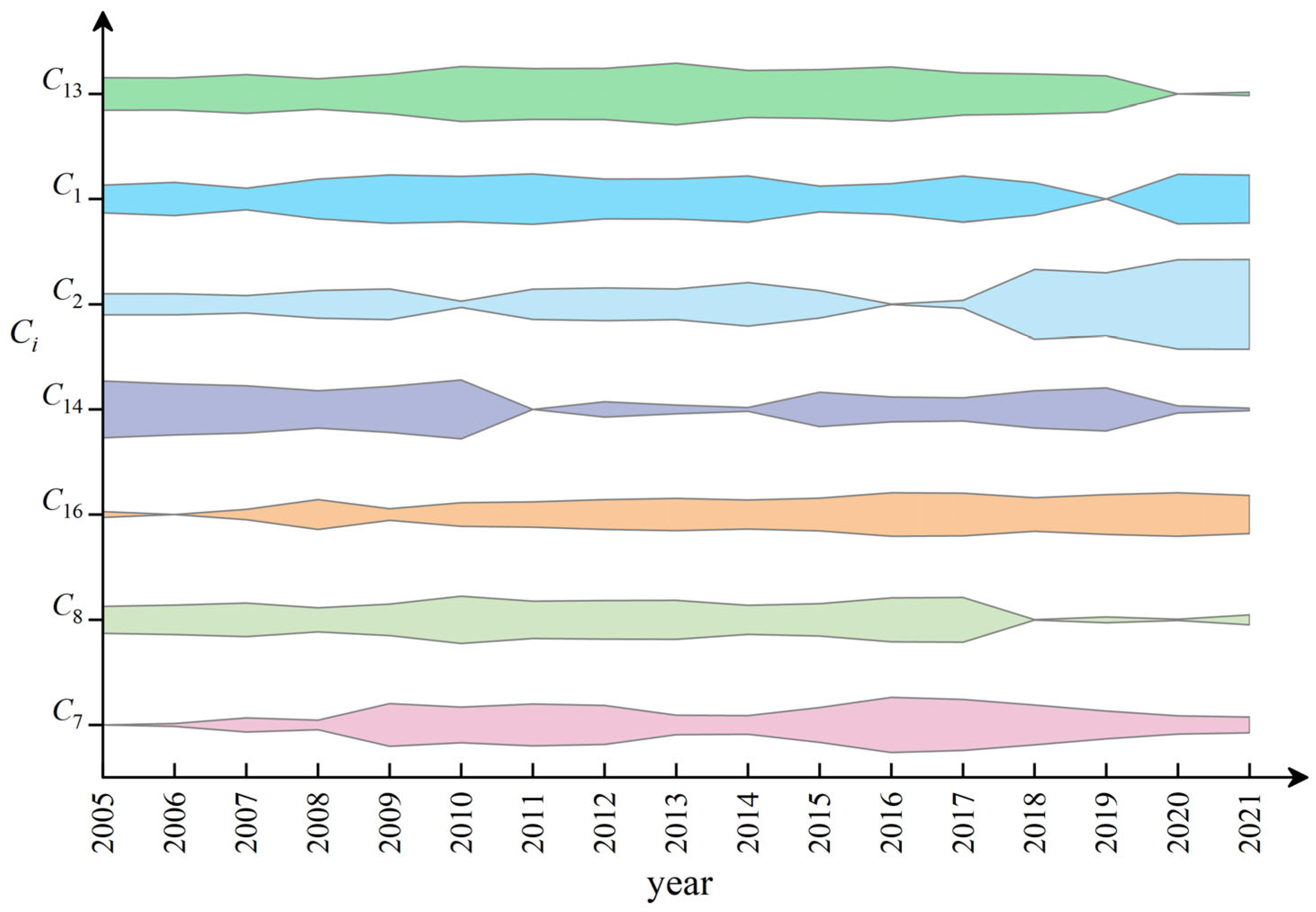
| 30 Impact Factors | 16 Impact Factors | The Difference in Matter-Element Model Evaluation Results | The Difference in Delphi Method Evaluation Results |
|---|---|---|---|
| Annual precipitation C1 | Annual precipitation C1 | 0.055 | 0.019 |
| Total water resources C2 | Total water resources C2 | ||
| Average water resource amount per capita C3 | Water yield modulus C3 | ||
| Surface water resource amount C4 | Groundwater resource amount C4 | ||
| Groundwater resource amount C5 | Water supply modulus C5 | ||
| Water resource amount per Mu C6 | Degree of surface water resource amount, exploration, and utilization C6 | ||
| Water supply modulus C7 | Degree of groundwater resource amount, exploration, and utilization C7 | ||
| Available water per capita C8 | Surface water control rate C8 | ||
| Degree of surface water resource amount, exploration, and utilization C9 | Available water per capita C9 | ||
| Degree of groundwater resource amount, exploration, and utilization C10 | Ecological and environmental water use ratio C10 | ||
| Water consumption rate C11 | Tillable land effective irrigation ratio C11 | ||
| Surface water control rate C12 | Domestic water ratio C12 | ||
| Population growth rate C13 | Ratio of irrigation water use on farmland C13 | ||
| Population density C14 | Annual quantity of wastewater effluent C14 | ||
| Urbanization rate C15 | Water use amount per unit GDP C15 | ||
| Day water consumption per capita C16 | Urbanization rate C16 | ||
| Domestic water ratio C17 | |||
| Tillable land ratio C18 | |||
| Tillable land effective irrigation ratio C19 | |||
| Water saving irrigation ratio C20 | |||
| Grain production per capita C21 | |||
| Farmland irrigation water use amount per Mu C22 | |||
| Ratio of irrigation water use on farmland C23 | |||
| Per capita GDP C24 | |||
| Water use amount per unit GDP C25 | |||
| Water use amount per CNY ten thousand of industrial added value C26 | |||
| Industrial water ratio C27 | |||
| Annual quantity of wastewater effluent C28 | |||
| Water yield modulus C29 | |||
| Ecological and environmental water use ratio C30 |
| Indicator Layer | Impact Factors | Property | Replacement Formula | Meaning |
|---|---|---|---|---|
| Natural fragility B1 | Annual precipitation C1 | - | Statistical data | Reflects the basic precipitation status of the river basin and has a direct impact on the runoff of surface rivers. |
| Total water resources C2 | - | Statistical data | Reflects the amount endowment status of water resources in the basin. | |
| Water yield modulus C3 | - | Total water resources/drainage area | Reflects the water yield by the basin itself. | |
| Groundwater resource amount C4 | - | Statistical data | Reflects the richness of groundwater resources in the basin. | |
| Anthropogenic fragility B2 | Water supply modulus C5 | - | Total water supply/drainage area | Reflects the ability of infrastructure such as water supply projects in the basin to support the social and economic development of the basin. |
| Degree of surface water resource amount, exploration, and utilization C6 | - | Surface water supply amount/surface water resource amount | Reflects the extent to which surface water is exploited within the basin and the potential for exploitation. | |
| Degree of groundwater resource amount, exploration, and utilization C7 | - | Groundwater supply amount/groundwater resources amount | Reflects the potential for the development of groundwater resources in the basin. | |
| Surface water control rate C8 | - | Annual water storage quantity of surface water storage project/surface water resources in the river basin | Reflects the capacity of surface water storage in the river basin. | |
| Available water per capita C9 | - | Actual water supply/total population of the basin | Reflects the water supply capacity of the water supply system and the ability of water resources to support regional development. | |
| Ecological and environmental water use ratio C10 | - | Ecological and environmental water use amount/total water use amount in the river basin | Reflects the water input for the restoration, construction, and maintenance of the ecological environment in the river basin. | |
| Bearing capacity fragility B3 | Tillable land effective irrigation ratio C11 | - | Effective irrigation area/total tillable land area of the river basin | Reflects the level of effective irrigation and the degree of food security in the river basin. |
| Domestic water ratio C12 | + | Domestic water consumption/total water use amount in the river basin | Reflects the scale of water used by residents in the basin. | |
| Ratio of irrigation water use on farmland C13 | + | Irrigation water use amount on farmland/total water use amount in the river basin | Reflects the water use efficiency of agricultural irrigation within the watershed. | |
| Annual quantity of wastewater effluent C14 | + | Statistical data | Reflects the degree of influence of sewage discharge in the river basin on the water quality of various water bodies in the river basin. | |
| Water use amount per capita GDP C15 | + | Total water use amount in the river basin/total GDP of the basin | Reflects the comprehensive water use efficiency, water saving degree, and industrial structure of the river basin. | |
| Urbanization rate C16 | + | Permanent urban population/total population of the basin | Reflects the level of socioeconomic development of the basin and the potential requirements for water quality and quantity. |
| Digital Features | Grade of Water Resource Vulnerability Evaluation | Fragile State | ||
|---|---|---|---|---|
| Ex 1 | En 2 | He 3 | ||
| 1 | 0.103 | 0.013 | I | Quite low fragility |
| 0.691 | 0.064 | 0.008 | II | Low fragility |
| 0.5 | 0.039 | 0.005 | III | Moderate fragility |
| 0.309 | 0.064 | 0.008 | IV | High fragility |
| 0 | 0.103 | 0.013 | V | Seriously high fragility |
| Factors | Weight: wa | Order | Weight: wb | Order | Weight: Ws | Order |
|---|---|---|---|---|---|---|
| C1 | 0.111 | 2 | 0.024 | 16 | 0.066 | 6 |
| C2 | 0.158 | 1 | 0.076 | 5 | 0.115 | 1 |
| C3 | 0.065 | 4 | 0.064 | 6 | 0.065 | 8 |
| C4 | 0.065 | 4 | 0.083 | 4 | 0.074 | 5 |
| C5 | 0.033 | 7 | 0.051 | 8 | 0.042 | 13 |
| C6 | 0.026 | 8 | 0.031 | 13 | 0.028 | 16 |
| C7 | 0.083 | 3 | 0.049 | 9 | 0.065 | 7 |
| C8 | 0.065 | 4 | 0.047 | 10 | 0.056 | 9 |
| C9 | 0.041 | 6 | 0.057 | 7 | 0.049 | 11 |
| C10 | 0.052 | 5 | 0.032 | 12 | 0.042 | 14 |
| C11 | 0.041 | 6 | 0.029 | 15 | 0.035 | 15 |
| C12 | 0.033 | 7 | 0.150 | 2 | 0.093 | 2 |
| C13 | 0.083 | 3 | 0.030 | 14 | 0.056 | 10 |
| C14 | 0.065 | 4 | 0.085 | 3 | 0.075 | 5 |
| C15 | 0.026 | 8 | 0.153 | 1 | 0.091 | 3 |
| C16 | 0.052 | 5 | 0.040 | 11 | 0.046 | 12 |
| Time | Matter-Element Model Evaluation Results | Fragility Level | Fragility State | Delphi Method Evaluation Results | Variation Coefficient | Fragility Level | Fragility State |
|---|---|---|---|---|---|---|---|
| 2005 | 0.485 | III | Moderate fragility | 0.440 | 11.2% | III | Moderate fragility |
| 2006 | 0.474 | III | Moderate fragility | 0.380 | 11.9% | IV | High fragility |
| 2007 | 0.419 | III | Moderate fragility | 0.360 | 13.7% | IV | High fragility |
| 2008 | 0.553 | III | Moderate fragility | 0.360 | 13.7% | IV | High fragility |
| 2009 | 0.452 | III | Moderate fragility | 0.560 | 14.4% | III | Moderate fragility |
| 2010 | 0.309 | IV | High fragility | 0.530 | 10.9% | III | Moderate fragility |
| 2011 | 0.363 | IV | High fragility | 0.380 | 13.0% | IV | High fragility |
| 2012 | 0.373 | IV | High fragility | 0.420 | 12.7% | II | Moderate fragility |
| 2013 | 0.366 | IV | High fragility | 0.370 | 12.5% | IV | High fragility |
| 2014 | 0.439 | III | Moderate fragility | 0.510 | 11.4% | III | Moderate fragility |
| 2015 | 0.425 | III | Moderate fragility | 0.560 | 12.0% | III | Moderate fragility |
| 2016 | 0.301 | IV | High fragility | 0.500 | 14.6% | III | Moderate fragility |
| 2017 | 0.322 | IV | High fragility | 0.370 | 12.5% | IV | High fragility |
| 2018 | 0.425 | III | Moderate fragility | 0.620 | 13.0% | II | Low fragility |
| 2019 | 0.447 | III | Moderate fragility | 0.290 | 10.4% | IV | High fragility |
| 2020 | 0.357 | IV | High fragility | 0.390 | 11.9% | IV | High fragility |
| 2021 | 0.363 | IV | High fragility | 0.400 | 13.4% | IV | High fragility |
| Time | Indicators | ||
|---|---|---|---|
| Natural Fragility B1 (%) | Anthropogenic Fragility B2 (%) | Bearing Capacity Fragility B3 (%) | |
| 2005 | 19.6 | 18.4 | 62 |
| 2006 | 20.2 | 20.2 | 59.6 |
| 2007 | 14.8 | 26.4 | 58.8 |
| 2008 | 25.2 | 20.2 | 54.6 |
| 2009 | 28.0 | 32.4 | 39.6 |
| 2010 | 14.3 | 33 | 52.8 |
| 2011 | 31.5 | 34.1 | 34.4 |
| 2012 | 30.6 | 33.9 | 35.5 |
| 2013 | 29.1 | 36 | 34.9 |
| 2014 | 37.2 | 34.3 | 28.5 |
| 2015 | 23.5 | 41.1 | 35.4 |
| 2016 | 7.7 | 54.4 | 37.9 |
| 2017 | 14.5 | 51.3 | 34.2 |
| 2018 | 34.2 | 27.8 | 38 |
| 2019 | 31.1 | 29.2 | 39.7 |
| 2020 | 59.6 | 12.8 | 27.6 |
| 2021 | 59.9 | 14.1 | 25.9 |
| Factors | C1 | C2 | C3 | C4 | C5 | C6 | C7 | C8 | C9 | C10 | C11 | C12 | C13 | C14 | C15 | C16 |
| Obstacle | 9.0 | 8.7 | 5.1 | 5.5 | 3.8 | 3.5 | 6.7 | 6.8 | 4.1 | 5.7 | 5.7 | 6.4 | 9.5 | 7.2 | 5.5 | 6.8 |
Disclaimer/Publisher’s Note: The statements, opinions and data contained in all publications are solely those of the individual author(s) and contributor(s) and not of MDPI and/or the editor(s). MDPI and/or the editor(s) disclaim responsibility for any injury to people or property resulting from any ideas, methods, instructions or products referred to in the content. |
© 2023 by the authors. Licensee MDPI, Basel, Switzerland. This article is an open access article distributed under the terms and conditions of the Creative Commons Attribution (CC BY) license (https://creativecommons.org/licenses/by/4.0/).
Share and Cite
Wu, L.; Qian, C.; Shen, Y.; Sun, D. Assessment and Factor Diagnosis of Water Resource Vulnerability in Arid Inland River Basin: A Case Study of Shule River Basin, China. Sustainability 2023, 15, 9052. https://doi.org/10.3390/su15119052
Wu L, Qian C, Shen Y, Sun D. Assessment and Factor Diagnosis of Water Resource Vulnerability in Arid Inland River Basin: A Case Study of Shule River Basin, China. Sustainability. 2023; 15(11):9052. https://doi.org/10.3390/su15119052
Chicago/Turabian StyleWu, Lanzhen, Chen Qian, Yilin Shen, and Dongyuan Sun. 2023. "Assessment and Factor Diagnosis of Water Resource Vulnerability in Arid Inland River Basin: A Case Study of Shule River Basin, China" Sustainability 15, no. 11: 9052. https://doi.org/10.3390/su15119052
APA StyleWu, L., Qian, C., Shen, Y., & Sun, D. (2023). Assessment and Factor Diagnosis of Water Resource Vulnerability in Arid Inland River Basin: A Case Study of Shule River Basin, China. Sustainability, 15(11), 9052. https://doi.org/10.3390/su15119052






